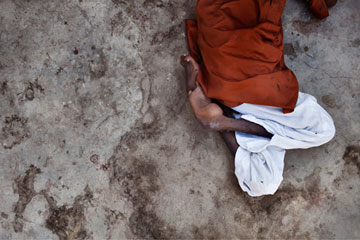
(4 of 5)
In the three endemic countries, a two-pronged strategy is thus being used: stay with the Sabin vaccine to wipe out naturally occurring polio, then use Salk to take care of any vaccine-related cases that remain. In the U.S., where cost and the greater difficulty of administering an injection are not issues, Salk is used almost exclusively. "The Salk vaccine never causes symptoms and never causes transmissible polio," says Gates. "It is a perfect vaccine."
Another complicating factor: polio is not just one disease; it's actually three. The virus comes in a trio of genetically distinct types, known prosaically enough as Type 1, Type 2 and Type 3, and each reacts differently to vaccines. The way to attack them all at once is to administer what's known as a trivalent vaccine, with three formulations in each drop or shot. That usually works, but not always. In Egypt, Types 2 and 3 were eradicated as early as 2004, but Type 1 refused to die.
"We worked with the Egyptian government to tighten up the whole operation," says Aylward. "We had them make sure their vaccination teams actually went to the top floors of all of the apartment buildings." Even that wasn't sufficient, however, and WHO decided that what was needed was a highly potent, monovalent vaccine to hit Type 1 alone. Pharma giant Sanofi Pasteur said it could develop it within 12 months. Aylward gave them four, and they settled on five. The Gates Foundation donated $10 million to the effort--enough to buy 50 million doses--and by 2006, polio was expelled from Egypt for good. In the three endemic countries, Type 1 is again causing headaches, with Type 2 eradicated and Type 3 getting close. But if you don't stay on top of the virus until the very last case of the very last strain is wiped out, polio will break free again.
All Medicine Is Local
There's no one way to flush those last cases out, and the right strategy depends on the country in question. Despite the shootings in Pakistan, the most worrisome place in terms of caseload is Nigeria. It's the only country whose polio rates actually went up in 2012, to 118 cases compared with 62 in 2011. (In Pakistan, there were 57 cases in 2012 and 198 in 2011.) Nigeria's problem area continues to be the north, with antivaccine propaganda again leading to refusals. In 2012, WHO dramatically increased its presence in the country, from 744 workers to 2,948. It is also using satellite mapping to reach children in villages that, says John Hewko, general secretary of Rotary International, "we didn't even know existed."
Afghanistan, so often a source of trouble in the region, is moving comparatively smoothly toward eradication, with just 35 cases in 2012, down from 80 in 2011. The Islamic Development Bank has made a $3 million grant to Afghanistan to help antipolio efforts. That's just a small fraction of the $227 million the bank made available to Pakistan, also for polio vaccinations, but the disparity in funding partly reflects the disparity in need. What's more, the fact that the bank is involved at all suggests a regional buy-in that was lacking before.
